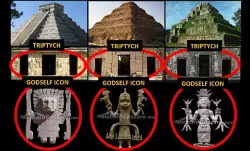The fallen astronaut - who installed the first monument on the Moon
People's imagination is boundless. They create on earth, violating all the laws of physics, underwater, installing impressive sea Atlanteans on the bottom of the seas and even on the Moon. In addition to 180 tons of garbage, people left an aluminum figure of an astronaut in a spacesuit lying face-up on the satellite. This sculpture was named "The Fallen Astronaut". It is the only man-made installation on the moon.

David Scott during the installation of "astronaut"
The figure is located at the landing site of Apollo 15 in the Hadley area near the Sea of Rains. It was placed here by David Scott in 1971. The statuette was not made alone. With it, a plaque arrived on the moon, on which the names of 14 American and Russian astronauts who had died or died by that time but were related to lunar missions, were immortalized.
History of creation
The Belgian Paul van Heydonk created the lunar masterpiece. He decided that it was time to leave a mark on the conquered space object after a conversation with David Scott. They discussed that the artist will create a figurine, the astronaut will take it with him on a flight and leave it on the lunar soil in memory of those who made a great contribution to space exploration.

Figure of Paul van Heydonk
The creator faced a serious task - it was necessary to create an astronaut without specifying gender and race. The figure had to withstand critical temperatures, be strong and light. Then Heydonk decided to take a closer look at the properties of aluminum. After analyzing its characteristics, the artist began to create it, and at that time David Scott made a nameplate. The astronaut did not want to announce the act, since it was created not for commercial purposes, but for the sake of memory. Therefore, the name of the author of the first space masterpiece was learned after the installation of the "Fallen Astronaut". Van Heydonk himself reacted to the concealment of the fact with a protest.
Later, Scott admitted that at first he thought of making only a commemorative plaque, and depicting the whole of humanity as an astronaut. But the cosmonaut did not want to stand during the installation, then he had to be put down, and in this form, he looked more like a "Fallen Astronaut", so this name was glued to him. Although no one chose the name and did not approve, everything came by itself.
How the earthlings found out about the sign on the moon.
When Apollo 15 arrived on Earth, the astronauts told that they had immortalized the memory of the 14 fathers of space exploration and installed a statuette on the moon.

A plaque made by Scott
The heads of the US Air and Space Museum said that the exhibition requires a copy of the"lunar inhabitant". It was made and exhibited in the museum, however, after the incident was announced in the media. So, the astronauts did not manage to honor the memory of their colleagues quietly. And Paul van Heydonk was already preparing copies of the figurines for sale, thereby violating the agreement with David Scott.
The man tried to urge the Belgian to keep his word, but until NASA stepped in, he wanted to benefit from the sale of copies of the statuette. Later, the artist admitted that he still created 50 astronauts exactly like on the Moon, but sold only one, and the rest are still with him.
About author:
Serg Toporkov Ufologist, Ph.D., blogger, I go on my own expeditions for UFOs. I use scientific methods to investigate the UAP phenomenon. Write to me |
Related tags:
Fallen astronaut NASA Apollo 15 Moon David Scott USA 1971 spaceRandom UFO or conspiracy article
The mysterious image of Godself is found all over the world
 Currently, there is considerable evidence that ancient civilizations around the world were connected by a powerful religious symbol, which I call the Image of God Himself, and which is especially noticeable in the architecture of the pyramids.
Currently, there is considerable evidence that ancient civilizations around the world were connected by a powerful religious symbol, which I call the Image of God Himself, and which is especially noticeable in the architecture of the pyramids.
